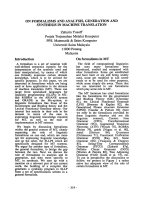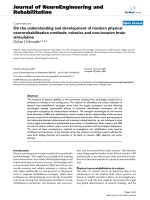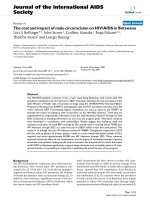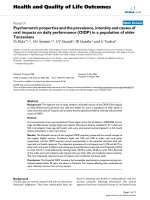Báo cáo hóa học: "ON EXPLICIT AND NUMERICAL SOLVABILITY OF PARABOLIC INITIAL-BOUNDARY VALUE PROBLEMS ALEXANDER KOZHEVNIKOV AND OLGA LEPSKY " pptx
Bạn đang xem bản rút gọn của tài liệu. Xem và tải ngay bản đầy đủ của tài liệu tại đây (549.17 KB, 12 trang )
ON EXPLICIT AND NUMERICAL SOLVABILITY OF
PARABOLIC INITIAL-BOUNDARY VALUE PROBLEMS
ALEXANDER KOZHEVNIKOV AND OLGA LEPSKY
Received 26 July 2005; Revised 15 January 2006; Accepted 22 March 2006
A homogeneous boundary condition is constructed for the parabolic equation (∂
t
+ I −
Δ)u = f in an arbitrary cylindrical domain Ω ×R (Ω ⊂ R
n
being a bounded domain, I
and Δ being the identity operator and the Laplacian) which generates an initial-boundary
value problem with an explicit formula of the solution u. In the paper, the result is ob-
tained not just for the operator ∂
t
+ I −Δ, but also for an arbitrary parabolic differential
operator ∂
t
+ A,whereA is an elliptic oper ator in R
n
of an even order with constant co-
efficients. As an application, the usual Cauchy-Dirichlet boundary value problem for the
homogeneous equation (∂
t
+ I −Δ)u = 0inΩ ×R is reduced to an integral equation in
a thin lateral boundary layer. An approximate solution to the integral equation generates
a rather simple numerical algorithm called boundary layer element method which solves
the 3D Cauchy-Dirichlet problem (with three spatial variables).
Copyright © 2006 A. Kozhe vnikov and O. Lepsky. This is an open access article distrib-
uted under the Creative Commons Attribution License, which permits unrestricted use,
distribution, and reproduction in any medium, provided the original work is properly
cited.
1. Introduction
It is well known that the initial-boundary value problem with the Dirichlet/Neumann
boundary condition for the parabolic equation (∂
t
+ I − Δ)u = f canbesolvedusing
the Green function. But the Green function can be found explicitly just for a few very
specific domains Ω such as balls and half-spaces. Unfortunately, in the case of an arbitrary
domain Ω, there is no explicit formula for the solution.
In this paper, the following question is investigated. How can one define boundary
conditions for an arbitrary domain Ω in order to obtain an explicitly solvable initial
boundary value problem? An answer is obtained not just for the operator ∂
t
+ I −Δ,but
also for a rather general parabolic differential operator of the form ∂
t
+ A,whereA is an
elliptic differential operator of even order with constant coefficients. Similar questions
for elliptic boundary value problems have been investigated in [4].
Hindawi Publishing Corporation
Boundary Value Problems
Volume 2006, Article ID 75458, Pages 1–12
DOI 10.1155/BVP/2006/75458
2 On explicit and numerical solvability
It turns out—and this is the first result of the paper—that by replacing the Dirichlet-
Neumann boundary condition with a more complicated homogeneous equation on
boundary, we obtain an explicitly solvable initial-boundary value problem. Moreover,
the solution can be represented by an explicit formula similar to the solution of the equa-
tion (∂
t
+ I −Δ)u = f over the w hole space R
n+1
. The anisotropic Sobolev spaces are very
natural for solvability of parabolic initial-boundary value problems. These spaces as well
as the solvability have been investigated by Slobodecki
˘
ı[9], Agranovi
ˇ
candVi
ˇ
sik [1], V.
A. Solonnikov (see, e.g., [5]), Lions and Magenes [6], Grubb [3], and Eidelman and Zhi-
tarashu [2].
Let n be the unit normal to ∂Ω,pointingtowardstheexteriorofΩ. To state the
boundary condition which gives an explicit solution, let us denote by Ψ
−
the Dirichlet-
Neumann operator which maps the boundary trace v
−
|
∂Ω×R
+
of a function v
−
satisfying
the equation (∂
t
+ I − Δ)v
−
(x, t) = 0((x,t) ∈ Ω
−
:= Ω) into the boundary trace of its
normal derivative ∂
n
v
−
|
∂Ω×R
+
. More precisely, Ψ
−
is a composition of a Poisson operator
[3, Section 3] solving the problem
∂
t
+ I −Δ
v
−
(x, t) =0, (x, t) ∈Ω
−
×R
+
,
v
−
(x,0) =0, x ∈ Ω
−
,
v
−
(x, t) =g(x, t), x ∈∂Ω,
(1.1)
and the trace operator ∂
n
v
−
|
∂Ω×R
+
. Replacing Ω
−
in (1.1)byΩ
+
:= Ω,weobtainthe
operator Ψ
+
. We show that the equation (∂
t
+ I −Δ)u
±
(x, t) = f
±
(x, t)((x,t) ∈Ω
±
×R
+
)
under the homogeneous boundary condition ∂
n
u
±
−Ψ
∓
u
±
= 0on∂Ω ×R
+
has a unique
solution belonging to an anisotropic Sobolev space. We note that the latter boundary
condition is parabolic, that is, the corresponding Lopatinskii condition holds.
As a consequence—and this is the second of two main results of the paper—the inte-
rior/exterior Cauchy-Dirichlet problem
∂
t
+ I −Δ
v
±
(x, t) =0, (x,t) ∈Ω
±
×R
+
,
v
±
(x,0) =0, x ∈ Ω
±
,
v
±
(x, t) =g(x,t), x ∈ ∂Ω,
(1.2)
is reduced to an integral equation in a thin exterior/interior lateral boundary layer of
∂Ω
×R
+
. An approximate solution of the integral equation generates a rather simple nu-
merical algorithm solving the interior/exterior Cauchy-Dirichlet problem i n the case of
Ω
±
⊂ R
n
(n =2,3). The algorithm is different from the methods of finite differences, fi-
nite elements, boundary elements, or difference potentials. It can be called boundary layer
element method. It is shown that any solution of the interior/exterior Cauchy-Dirichlet
problem with zero initial data is represented in the form of the l ayer potential with an
unknown density supported in an arbitrarily thin exterior/interior boundary layer. Such
A. Kozhevnikov and O. Lepsky 3
layer potential representation is simpler than the representation by either simple-layer
or double-layer potentials in the boundary e lement method or related representation
by d ifference potentials [8]. Further, the standard cubic grid, just as in finite difference
method, is used for the calculation of the unknown density. We reduce the problem to
a linear system of NM equations, where N is the number of cubic cells inside the thin
exterior boundary layer to Ω
⊂ R
3
,andM is the number of time le vels. It turns out that
the system has a lower block-triangular matrix with M equal diagonal blocks. Each block
is a square matrix of order N. The solution of the system needs const
·N
3
M operations
and is obtained using a standard PC for N
= 536, M = 10. Examples of an accuracy of the
method are presented.
Thefirstequation(∂
t
+ I −Δ)v
±
(x, t) = 0in(1.2) may be replaced by the usual heat
equation (∂
t
−Δ)u
±
(x, t) =0duetothefactthatifv( x, t) satisfies (1.2), then the function
u
±
= e
−t
v
±
is a solution to the following Cauchy-Dirichlet problem:
∂
t
−Δ
u
±
(x, t) =0, (x,t) ∈Ω
±
×R
+
,
u
±
(x,0) =0, x ∈ Ω
±
,
u
±
(x, t) =e
t
g(x,t), x ∈ ∂Ω.
(1.3)
In the next section, instead of I
−Δ, we consider a more general case, that is, an ar-
bitrary invertible elliptic differential operator A of even order 2m with constant coeffi-
cients. We prove that under appropriate homogeneous boundary conditions, the operator
∂/∂t + A generates an isomorphism between anisotropic Sobolev spaces with an explicit
formula for the inverse operator.
In [4], similar results are obtained for the elliptic equation (I
−Δ)u = f ,aswellasfor
its generalization (I
−A)u = f .
2. Theorem on explicit solvabilit y
Some prerequisites, such as the definition of the weighted anisotropic Sobolev spaces as
well as a result on solvability of the Cauchy-Dirichlet problem, are collected below before
the statement of Theorem 2.2.
Let A be a linear differential operator in
R
n
of an even order 2m (m ∈N
+
:={1,2, }),
with constant coefficients a
α
∈ C, that is, A :=A(D):=
|α|≤2m
a
α
D
α
,whereα is a multi-
index, that is, α :
= (α
1
, ,α
n
), α
j
∈ N :={0,1, 2, }, |α|:=α
1
+ ···+ α
n
, i :=
√
−1; D
j
:=
i
−1
∂/∂x
j
; D
α
:= D
α
1
1
D
α
2
2
···D
α
n
n
.
Let ∂Ω be a closed compact infinitely smooth surface in
R
n
bounding a domain Ω
+
and let Ω
−
be the complement of Ω
+
in R
n
,whereΩ
+
is the closure of Ω
+
.
We consider two equations:
∂
t
+ A(D)
u
±
(x, t) = f
±
(x, t), either (x,t) ∈Ω
+
×R
+
or (x,t) ∈Ω
−
×R
+
, (2.1)
in short (∂
t
+ A(D))u
±
(x, t) = f
±
(x, t), x ∈Ω
±
×R
+
.
The polynomials a(ξ):
=
|α|≤2m
a
α
ξ
α
and a
0
(ξ):=
|α|=2m
a
α
ξ
α
are called, respec-
tively, the symbol and the principal symbol of A. Let the following condition be satisfied.
4 On explicit and numerical solvability
Condition 2.1. There is a constant c>0suchthat
q
2m
+ a
0
(ξ)
≥
c
|
ξ|+ |q|
2m
for ξ ∈ R
n
, |argq|≤
π
4m
. (2.2)
Weighted anisotropic Sobolev spaces. Let 0
≤ s ∈ R and Ω coincide with either R
n
or R
n
+
:=
{
x = (x
1
, ,x
n
) ∈ R
n
: x
n
> 0} or Ω
±
.LetH
s
(Ω) denote the usual Sobolev spaces over
Ω. Following [1, 9], we consider the anisotropic Sobolev space H
(s,s/d)
(Ω ×R)(0≤ s ∈
R
, d ∈ N
+
), that is, the completion of the set of all smooth functions u(x,t) with respect
to the norm
u
2
H
(s,s/d)
(Ω ×R):=
∞
0
u(x,t)
2
H
s
(Ω)
dt +
Ω
u(x,t)
2
H
s/d
(R)
dx. (2.3)
Let H
s
(∂Ω) denote the Sobolev spaces over the smooth surface ∂Ω,andletH
(s,s/d)
(∂Ω
×R) be the anisotropic Sobolev space of functions u(x
,t)(x
∈ ∂Ω) with the norm
u
2
H
(s,s/d)
(∂Ω×R)
:=
∞
0
u(x
,t)
2
H
s
(∂Ω)
dt +
j
∂Ω
ϕ
j
(x
)u(x
,t)
2
H
s/d
(R)
dx
, (2.4)
where
{ϕ
j
} is a partition of unity on ∂Ω such that
u
2
H
s
(∂Ω)
:=
j
ϕ
j
(x
)u
2
H
s
(R
n−1
)
. (2.5)
For δ
≥ 0, let H
(s,s/d)
(0)
(Ω ×R
+
,δ)(0≤ s ∈ R, d ∈ N
+
) denote the weighted anisotropic
Sobolev space of all functions u(x,t)definedinΩ
×R and equal zero for t<0andsuch
that e
−δt
u ∈H
(s,s/d)
(Ω ×R). The norm in this space is defined by
u
H
(s,s/d)
(0)
(Ω×R
+
,δ)
:=
e
−δt
u
H
(s,s/d)
(Ω×R)
. (2.6)
Similarly, H
(s,s/d)
(0)
(∂Ω ×R
+
,δ)(0≤ s ∈ R, d ∈N
+
) denotes the weighted anisotropic Sob-
olev space of all functions u(x
,t)definedin∂Ω ×R and equal zero for t<0andsuch
that e
−δt
u ∈H
(s,s/d)
(∂Ω ×R). The norm in this space is defined by
u
H
(s,s/d)
(0)
(∂Ω×R
+
,δ)
:=
e
−δt
u
H
(s,s/d)
(∂Ω×R)
. (2.7)
Let D
n
:= i
−1
∂
n
. It is known that the trace operators are continuos and surjective:
u
−→ D
j
n
u|
∂Ω×R
+
: H
(s,s/d)
(0)
Ω
±
×R
+
,δ
−→
H
(s−j−1/2,(s−j−1/2)/d)
(0)
∂Ω ×R
+
,δ
(2.8)
for s>j
−1/2.
Let
g
j
(x
,t) ∈H
(2m−j−1/2,(2m−j−1/2)/(2m))
(0)
∂Ω ×R
+
,δ
( j = 1, ,m −1). (2.9)
A. Kozhevnikov and O. Lepsky 5
For the homogeneous equations (2.1), we consider two Cauchy-Dirichlet problems (one
over Ω
+
×R
+
and the other over Ω
−
×R
+
):
∂
t
+ A(D)
v
±
= 0, in Ω
±
×R
+
,
D
j
n
v
±
= g
j
( j = 0,1, ,m −1), on ∂Ω ×R
+
,
v
±
|
t=0
= 0, on Ω
±
.
(2.10)
By the Laplace transform, the Cauchy-Dirichlet problem (2.10) can be formally reduced
to the corresponding boundary value problem depending on the complex parameter p :
p + A(D)
V
±
(x, p) =0, x ∈ Ω
±
,
D
j
n
V
±
(x
, p) =G
j
(x
, p)(j = 0,1, ,m −1), x
∈ ∂Ω.
(2.11)
Under condition (2.2), there exists γ>0suchthatforRep>γ,theproblem(2.11)has
a unique solution belonging to an appropriate Sobolev space. This assertion has been
stated in [10, T heorem 1.4], where it is noted that for the bounded domain Ω
+
, this fact is
proved in [1], however, the localization technique used in [1] enables one to establish the
assertion for the unbounded domain Ω
−
. In view of this and using [1, Theorem 9.2], we
obtain that the Cauchy-Dirichlet problem (2.10) has a unique solution v
±
∈ H
(2m,1)
(0)
(Ω
±
×
R
+
,δ).
By Ᏸ and ᏺ, we denote the vector operators
Ᏸ :
=
I,D
n
, ,D
m−1
n
|
∂Ω×R
+
,
ᏺ :
=
D
m
n
, ,D
2m−1
n
|
∂Ω×R
+
.
(2.12)
It is known that if v
±
(x, t) is the solution of (2.10), the vectors Ᏸv
±
and ᏺv
±
are related
by the equation
ᏺv
±
= Ψ
±
Ᏸv
±
. (2.13)
Here Ψ
±
:={Ψ
±, jk
}
j,k=1, ,m
is an m ×m matrix operator acting on ∂Ω ×R
+
which can
be called a D irichlet-to-Neumann mapping. We note that Ψ
±, jk
is an operator of order
κ := m + j −k mapping t he space H
(s,s/(2m))
(0)
(Ω
±
×R
+
)toH
(s−κ,(s−κ )/(2m))
(0)
(Ω
±
×R
+
).
Let Φ :
={Φ
jk
}
j,k=1, ,m
be another m ×m matrix operator acting on ∂Ω ×R
+
such that
ord Φ
jk
= m+ j −k.
For f
+
(x, t) ∈ L
2
(Ω
+
×R
+
,δ), we consider the following conjugation problem (a par-
ticular case of a conjugation problem studied in [2]):
∂
t
+ A(D)
u
+
(x, t) = f
+
(x, t), (x,t) ∈Ω
+
×R, (2.14)
∂
t
+ A(D)
u
−
(x, t) =0, (x,t) ∈Ω
−
×R, (2.15)
Ᏸu
+
x
,t
−
Ᏸu
−
(x
,t) =0, (x
,t) ∈∂Ω
+
×R, (2.16)
ᏺu
+
(x
,t) −Φ
Ᏸu
+
(x
,t) =0, (x
,t) ∈∂Ω
+
×R, (2.17)
u
+
(x,0) =0, x ∈ Ω
+
, (2.18)
u
−
(x,0) =0, x ∈ Ω
−
. (2.19)
6 On explicit and numerical solvability
We w ill call the function u(x,t) a solution to the conjugation problem if with some δ>0,
u(x,t):
=
⎧
⎪
⎨
⎪
⎩
u
+
(x, t) ∈H
(2m,1)
(0)
Ω
+
×R
+
,δ
,(x, t) ∈Ω
+
×R,
u
−
(x, t) ∈H
(2m,1)
(0)
Ω
−
×R
+
,δ
,(x, t) ∈Ω
−
×R,
(2.20)
and (2.14)–(2.19)hold.
Theorem 2.2. Let Condition 2.1 be sat isfied.
Then for any f
+
(x, t) ∈L
2
(Ω
+
×R
+
,δ) with some δ>0, the conjugation problem (2.14)–
(2.19)hasa“smooth”solutionu(x, t)
∈ H
(2m,1)
(0)
(R
n
×R
+
,δ) if and only if u(x,t) satisfies
(2.17)withΦ replaced by Ψ
−
.
If Φ
= Ψ
−
,thesolutionu(x,t), and consequently u
+
(x, t) and u
−
(x, t), can be represented
as
u(x,t)
=
t
0
dτ
R
n
Ξ(t −τ,x −ξ) f
+
(τ,ξ)dξ, (2.21)
where the function Ξ(t,x) is the fundamental solution to the equation (∂
t
+ A(D))u = f
+
,
that is,
Ξ(x,t)
= Ᏺ
−1
(ξ,τ)
→(x,t)
1
iτ + a(ξ)
, (2.22)
and Ᏺ
−1
(ξ,τ)
→(x,t)
denotes the inverse Fourier transform.
If Φ
= Ψ
−
, the Cauchy-Dirichlet problem (2.14), (2.17), and (2.18) is parabolic (i.e., the
corresponding parameter-dependent problem satisfies the Lopatinskii condit ion) and unique-
ly solvable and the operator Ᏸu
+
mapssurjectivelythesetofallsolutionsu
+
(x, t) ∈ H
(2m,1)
(0)
(Ω
+
×R
+
,δ) satisfying (2.17)ontothespace
m−1
j=0
H
(2m−j−1/2,(2m−j−1/2)/2m)
(0)
∂Ω ×R
+
,δ
. (2.23)
Proof. Let u(x, t)
∈ H
(2m,1)
(0)
(R
n
×R
+
,δ) be a solution to the conjugation problem (2.14)–
(2.19). Then, by (2.15)and(2.16), we get
Ψ
−
Ᏸu
+
(x
,t) =Ψ
−
Ᏸu
−
(x
,t) =ᏺu
−
(x
,t). (2.24)
Since u(x,t)
∈ H
(2m,1)
(R
n
×R
+
,δ), ᏺu
−
(x
,t) =ᏺu
+
(x
,t). By (2.17), we have
Ψ
−
Ᏸu
+
(x
,t) =ᏺu
−
x
,t
=
ᏺu
+
(x
,t) =Φ
Ᏸu
+
(x
,t). (2.25)
Therefore, Φ(Ᏸu
+
)(x
,t) =Ψ
−
(Ᏸu
+
)(x
,t), which proves the necessity.
Now, let u
+
(x, t) ∈ H
(2m,1)
(0)
(Ω
+
× R
+
,δ)andu
−
(x, t) ∈ H
(2m,1)
(0)
(Ω
−
× R
+
,δ) satisfy
(2.14)–(2.19)withΦ
= Ψ
−
.Inparticular,u
+
(x, t) satisfies (2.14), (2.17), and (2.18), that
A. Kozhevnikov and O. Lepsky 7
is, u
+
(x, t) is a solution to the initial boundary value problem
∂
t
+ A(D)
u
+
(x, t) = f
+
(x, t), (x,t) ∈Ω
+
×R
+
,
ᏺu
+
(x, t) −Ψ
−
Ᏸu
+
(x, t)
=
0, (x,t) ∈∂Ω
+
×R
+
,
u
+
(x,0) =0, x ∈ Ω
+
.
(2.26)
Following [1], to check the Lopatinskii condition, we suppose that Ω
+
is a hyperplane
x
n
> 0andreplace∂
t
by q
2m
,replaceA(D) = A(D
,D
n
) by its principal part A
0
(D
,D
n
),
and then by a
0
(ξ
,D
n
). In this case, it is enough to check that for f
+
(x, t) ≡0, the solution
u
+
(x
,x
n
,q) ∈H
2m
(R
n−1
×R
+
)totheproblem
q
2m
+ A
0
D
,D
n
u
+
x
,x
n
,q
=
0, x
∈ R
n−1
, x
n
∈ R
+
, |argq|≤
π
4m
,
D
m+k
n
u
+
(x
,0,q) −Ψ
−
D
k
n
u
+
(x
,0,q)
=
0, k = 0,1, ,m −1,
lim
x
n
→∞
u
+
x
,x
n
,q
=
0
(2.27)
is the identical zero. Indeed, the Cauchy data of u
+
belongs to the subspace
ᏺu
+
(x
,q) −Ψ
−
Ᏸu
+
(x
,q) =0. (2.28)
On the other hand, since u
+
is the solution to the homogeneous equation
q
2m
+ A
0
(D)
u
+
(x, q) =0, (2.29)
its Cauchy’s data belongs to the subspace
ᏺu
+
(x
,q) −Ψ
+
Ᏸu
+
(x
,q) =0. (2.30)
It is known [10, Proposition 2.3] that under Condition 2.1, the intersection of two sub-
spaces consists solely of the zero element, that is, the Lopatinskii condition holds. This
together means that the problem (2.26) is parabolic.
Now, let f
+
(x, t) ∈ L
2
(Ω
+
×R
+
,δ)andu
+
(x, t) ∈ H
(2m,1)
(0)
(Ω
+
×R
+
,δ)beasolutionto
the problem (2.26). By (2.8), we have
Ᏸu
+
∈
m−1
j=0
H
(2m−j−1/2,(2m−j−1/2)/(2m))
(0)
∂Ω ×R
+
,δ
. (2.31)
We denote by u
−
(x, t) the solution to the Cauchy-Dirichlet problem
∂
t
+ A(D)
u
−
(x, t) =0, (x,t) ∈Ω
−
×R
+
,
Ᏸu
−
(x
,t) =Ᏸu
+
(x
,t), (x,t) ∈∂Ω ×R
+
,
u
−
(x,0) =0, x ∈ Ω
−
.
(2.32)
There exists a unique solution to the latter problem u
−
(x, t) ∈H
(2m,1)
(0)
(Ω
−
×R
+
,δ).
8 On explicit and numerical solvability
In view of the definition of the Dirichlet-to-Neumann mapping, we have
ᏺu
−
(x, t) =Ψ
−
Ᏸu
−
(x, t)) =Ψ
−
(Ᏸu
+
(x, t)
=
ᏺu
+
(x, t). (2.33)
Therefore, we get for the functions u
±
(x, t)belongingtoH
(2m,1)
(0)
(Ω
±
×R
+
,δ) that their
normal derivatives up to order 2m
−1 coincide on the interface ∂Ω. From this follows that
the function u(x,t)definedby(2.20)belongstoH
(2m,1)
(0)
(R
n
×R
+
,δ). Moreover, u(x,t)
satisfies the equation
∂
t
+ A(D)
u(x,t) = f (x,t), (x,t) ∈R
n
×R, (2.34)
where
f (x, t)
=
⎧
⎨
⎩
f
+
(x, t), (x,t) ∈Ω
+
×R
+
0, (x, t) ∈Ω
−
×R
+
.
(2.35)
Thus, it was proved that each solution to (2.26) has a smooth extension which satisfies
(2.34). Conversely, let us prove that each solution to (2.34)with f
+
(x, t) ∈L
2
(Ω
+
×R
+
,δ)
satisfies (2.14)–(2.19). Indeed, since u
∈ H
(2m,1)
(0)
(R
n
×R
+
,δ), we have for u
+
= u|
Ω
+
and
u
−
= u|
Ω
−
that
Ᏸu
+
(x
,t) =Ᏸu
−
(x
,t), ᏺu
+
(x
,t) =ᏺu
−
(x
,t). (2.36)
Since (∂
t
+ A(D))u
−
= 0, then ᏺu
−
(x
,t) = Ψ
−
(Ᏸu
−
)(x
,t), and therefore ᏺu
+
(x
,t) −
Ψ
−
(Ᏸu
+
)(x
,t) = 0. It follows that u
+
and u
−
satisfy (2.14)–(2.19). In particular, the re-
striction u
+
of u is a unique s olution to (2.26). This means t hat the parabolic problem
(2.26) has a unique solution u
+
(x, t)belongingtoH
(2m,1)
(0)
(Ω
+
×R
+
,δ) for each right-hand
side f
+
(x, t) ∈L
2
(Ω
+
×R
+
,δ). In view of (2.34), we get the for mula (2.21).
To prove the last sentence of the theorem, we use the known fact that the operator Ᏸ
maps surjectively the space H
(2m,1)
(0)
(Ω
+
×R
+
,δ) onto the space
m−1
j=0
H
(2m−j−1/2,(2m−j−1/2)/(2m))
(0)
(∂Ω ×R
+
,δ). (2.37)
Let us note that the boundary condition ᏺu
+
(x
,t) = Ψ
−
(Ᏸu
+
)(x
,t) means that there
are no constraints for the Dirichlet data Ᏸu
+
(x
,t) and just restrictions for the Neu-
mann data ᏺu
+
(x
,t). Therefore, the operator Ᏸ mapssurjectivelythesubspaceofall
solutions u
+
(x, t) ∈ H
(2m,1)
(0)
(Ω
+
×R
+
,δ) satisfying ᏺu
+
(x
,t) = Ψ
−
(Ᏸu
+
)(x
,t)ontothe
space (2.37).
3. Numerical algorithm to the exterior/interior Cauchy-Dirichlet problem
Near ∂Ω a normal vector field, n(x)
= (n
1
(x), ,n
n
(x)) is defined as follows: for x
0
∈ ∂Ω,
n(x
0
) is the unit normal to ∂Ω, pointing towards the exterior of Ω
+
.Wesetn(x):= n(x
0
)
for x of the form x
= x
0
−sn(x
0
) =: ζ(x
0
,s), where x
0
∈ ∂Ω, s ∈ (−ε,ε). Here ε>0istaken
to be so small that the representation of x in terms of x
0
∈ ∂Ω and s ∈ (−ε,ε)isunique
A. Kozhevnikov and O. Lepsky 9
and smooth, that is, ζ is bijective and C
∞
with C
∞
inverse, from ∂Ω ×(−ε,ε) to the set
ζ(∂Ω
×(−ε, ε)) ⊂ R
n
. We denote by Ω
bl
+
:= ζ(∂Ω ×(0,ε)) the interior boundary layer to
∂Ω, and denote by Ω
bl
−
:= ζ(∂Ω ×(−ε,0)) the exterior boundary layer to ∂Ω. Let us note
that Ω
bl
+
⊂ Ω
+
and Ω
bl
−
⊂ Ω
−
.
We denote t he complements to the boundary layers by
Ω
bl
±
:=
R
n
\Ω
bl
±
,whereΩ
bl
±
is
the closure of Ω
bl
±
.
The theorem remains valid after the replacement of Ω
+
and Ω
−
, respectively, by the
boundary layers Ω
bl
±
and by Ω
bl
±
in the statement of the theorem as well as in the state-
ment of the conjugation problem (2.14)–(2.19). The proof is similar.
As a result, we obtain
u
∓
(x, t):=
t
0
dτ
Ω
bl
±
Ξ(t −τ,x −ξ) f
±
(τ,ξ)dξ,
f
±
∈ L
2
Ω
bl
±
×R
+
,δ
.
(3.1)
Moreover, the function u
∓
(x, t) is a solution to the Cauchy-Dirichlet problem
∂
t
+ A(D)
u
∓
(x, t) =0, in (x,t) ∈Ω
∓
×R
+
, u
∓
∈ H
(2m,1)
Ω
∓
×R
+
,δ
,
Ᏸu
∓
|
∂Ω×R
+
= g,on∂Ω ×R
+
,
u
∓
|
t=0
= 0, on Ω
∓
,
(3.2)
if and only if f
±
(x, t)isasolutiontotheintegralequation
g(x,t)
= Ᏸ
t
0
dτ
Ω
bl
±
Ξ(t −τ,x −ξ) f
±
(τ,ξ)dξ (x,t) ∈∂Ω ×R
+
. (3.3)
Using the latter integral equation, let us construct an approximate solution to the
Cauchy-Dirichlet problem
∂
t
+ I −Δ
u
+
(x, t) =0, in Ω
+
×(0,T), u
+
∈ H
(2,1)
Ω
+
×(0,T)
,
u
+
|
∂Ω×(0,T)
= g(x,t), on ∂Ω ×(0,T), g(x, t) ∈H
(3/2,3/4)
∂Ω ×(0, T)
,
u
+
|
t=0
= 0, on Ω
+
.
(3.4)
We consider a rectangular grid in the space
R
n
(n = 1,2, 3) and choose only those cells
which belong to the thin exterior boundary layer Ω
bl
−
. Denoting these cells by ω
k
(k =
1, ,N), we define the indicator f
k,r
(x, t) of the set ω
k
×(t
r−1
,t
r
), where t
j
= jT/M, j =
0,1, ,M, that is,
f
k,r
(x, t):=
⎧
⎨
⎩
1, x ∈ ω
k
×
t
r−1
,t
r
,
0 otherwise.
(3.5)
We introduce basic functions
F
k,r
(x, t):=
t
0
dτ
ω
k
Ξ
t −τ,x −ξ
f
k,r
(τ,ξ)dξ,(x,t) ∈Ω
+
×R
+
. (3.6)
10 On explicit and numerical solvability
Let us note that since the functions f
k,r
are linearly independent and the operator in the
right-hand side of (3.6) is invertible, then the functions F
k,r
are linearly independent.
It is not difficult to evaluate F
k,r
numerically. Indeed, the interior integral over the cell
ω
k
=
ξ
i−1
,ξ
i
×
η
i−1
,η
i
×
ζ
i−1
,ζ
i
⊂ R
3
(3.7)
can be obtained as an algebraic expression including different values of the error function
erf(x):
= (2/
√
π)
x
0
exp(−p
2
)dp.Let
Ξ
i
(τ,ξ):= erf
ξ
i
−ξ
2
√
τ
−
erf
ξ
i−1
−ξ
2
√
τ
, ξ,ξ
i
∈ R, τ>0. (3.8)
Then for x
= (ξ,η,ζ) ∈R
3
,weobtain,inviewof(3.5),
F
k,r
(x, t) =F
k,r
(ξ,η,ζ,t) =
⎧
⎪
⎪
⎪
⎪
⎪
⎪
⎪
⎪
⎪
⎨
⎪
⎪
⎪
⎪
⎪
⎪
⎪
⎪
⎪
⎩
2
−3
t−t
m−1
0
Ξ
i
(τ,ξ)Ξ
j
(τ,η)Ξ
l
(τ,ζ)e
τ
dτ, t ∈
t
m−1
,t
m
,
2
−3
t−t
m−1
t−t
m
Ξ
i
(τ,ξ)Ξ
j
(τ,η)Ξ
l
(τ,ζ)e
τ
dτ, t>t
m
,
0, t
≤ t
m−1
.
(3.9)
The integral in the variable τ is calculated numerically. Analogously to the boundary ele-
ment method, the basic functions F
k,r
(x, t)canbecalledlateralboundarylayerelements.
Looking for an approximate solution to (3.4)intheform
v(x,t)
=
N
k=1
M
r=1
c
k,r
F
k,r
(x, t), (3.10)
we use NM different points (x
j
,t
i
) ∈ ∂Ω ×(0,T)(j = 1, ,N, i = 1, ,M)toconstruct
a linear system with respect to c
k,r
:
g
x
j
,t
i
=
N
k=1
M
r=1
c
k,r
F
k,r
x
j
,t
i
( j = 1, ,N, i =1, ,M). (3.11)
It turns out that the system has a lower block-triangular matrix with equal diagonal
blocks. Each block is a square matrix of order N. Therefore, to solve the system using
the Gaussian elimination, we need the number of operations which is proportional to
N
3
M. Solving the latter system, we obtain an approximate solution to the problem (3.4)
in the form (3.10).
Calculating numerically the norm
v −g in the space L
2
(∂Ω ×(0, T)) and comparing
it with
g, we get an accuracy of the approximate solution. We can also compare the
values of v(x,t)in(3.10)andg(x,t)in(3.4)atdifferent points of the lateral boundary
∂Ω
×R
+
and take into account the maximum principle.
Similarly, replacing the exterior boundary layer Ω
bl
+
by the interior boundary layer
Ω
bl
−
and considering the corresponding indicators f
k,r
, we get a solution to the exterior
Cauchy-Dirichlet problem in the form (3.10).
A. Kozhevnikov and O. Lepsky 11
Numerical examples. We will consider the problem (3.4)inthecylinderΩ
+
× [0,T],
where T
= 2.5, Ω
+
:={x = (x
1
,x
2
,x
3
) ∈ R
3
: r :=
x
2
1
+ x
2
2
+ x
2
3
< 1} is the unit ball, and
g(x,t):
= t. Let us construct numerical approximations of these solutions using the previ-
ous algorithm. The algori thm was implemented in C. We consider three Cartesian cubic
grids with step sizes h
= 1,0.5,025. Using these grids, we produce exterior boundary lay-
ers for the unit ball Ω which consists, respectively, of either 128, or 224, or 536 cells.
We choose the same number of either 128, or 224, or 536 boundary points belonging to
the intervals connecting the centers of the boundary layer cells with the origin. To con-
struct the boundary layer of the cylinder Ω
+
×[0, T], we put M = 10. To calculate the
coefficients F
k
(x
j
) of the linear system (3.11), we evaluate the inte grals (3.6) using the
following known procedure of the ten-point Gaussian integration for an integral over the
interval [a, b] (see, e.g., [7, Section 4.5]). Solving the linear system (3.11) using the stan-
dard LU decomposition for equal diagonal blocks (see, e.g., [7, Section 2.3]), we get the
coefficients c
k,r
.Thenby(3.10), we can obtain values of the approximate solution v(x,t)
in different points. Integrating numerically, we get the relative error
v −g
L
2
(∂Ω×(0,T))
g
L
2
(∂Ω×(0,T))
≈
⎧
⎪
⎪
⎪
⎨
⎪
⎪
⎪
⎩
0.358 for h =1,
0.031 for h
= 0.5,
0.0031 for h
= 0.25.
(3.12)
Thus, the presented numerical method gives a rather accurate approximation. The results
obtained so far are quite encouraging but we have considered only relatively simple test
cases. We plan to consider more sophisticated cases in the near future.
Acknowledgment
The authors gratefully acknowledge the many helpful suggestions of the referee.
References
[1] M.S.Agranovi
ˇ
candM.I.Vi
ˇ
sik, Elliptic problems with a parameter and parabolic problems of
general type, Uspekhi Matematicheskikh Nauk 19 (1964), no. 3 (117), 53–161, Russian Mathe-
matical Surveys 19, 53–159.
[2] S. D. Eidelman and N. V. Zhitarashu, Parabolic Boundary Value Problems,OperatorTheory:
Advances and Applications, vol. 101, Birkh
¨
auser, Basel, 1998.
[3] G. Grubb, Parameter-elliptic and parabolic pseudodifferential boundary problems in global L
p
Sobolev spaces, Mathematische Zeitschrift 218 (1995), no. 1, 43–90.
[4] A. Kozhevnikov, On explicit solvability of an e lliptic boundary value problem and its application,
Applicable Analysis 84 (2005), no. 8, 789–805.
[5] O. A. Ladyzhenskaya, V. A. Solonnikov, and N. N. Uralzeva, Linear and Quasi-Linear Equations
of Parabolic Type, American Mathematical Society, Rhode Island, 1968.
[6] J L. Lions and E. Magenes, Non-Homogeneous Boundary Value Problems and Applications. Vol.
II, Die Grundlehren der mathematischen Wissenschaften, vol. 182, Springer, New York, 1972.
[7] W.H.Press,B.P.Flannery,S.A.Teukolsky,andW.T.Vetterling,Numerical Rec ipes in C. The Art
of Scientific Computing, Cambridge University Press, Cambridge, 1988.
12 On explicit and numerical solvability
[8] V. S. Ryaben’kii, Method of Difference Potentials and Its Applications, Springer Series in Compu-
tational Mathematics, vol. 30, Springer, Berlin, 2002.
[9] L.N.Slobodecki
˘
ı, Generalized Sobolev spaces and their application to boundary problems for par-
tial differential equations, Leningradskii Gosudarstvennyi Pedagogi
ˇ
ceskii Institute U
ˇ
cenye Za-
piski 197 (1958), 54–112.
[10] L. R. Volevich and A. R. Shirikyan, Stable and unstable manifolds for nonlinear elliptic equations
with a parameter, Transactions of the Moscow Mathematical Society 2000 (2000), 97–138.
Alexander Kozhevnikov: Department of Mathematics, University of Haifa, Haifa 31905, Israel
E-mail address:
Olga Lepsky: Department of Mathematics, Natural Sciences Programs, Lesley Collage,
Lesley University, 29 Everett Street, Cambridge, MA 02138, USA
E-mail address:









